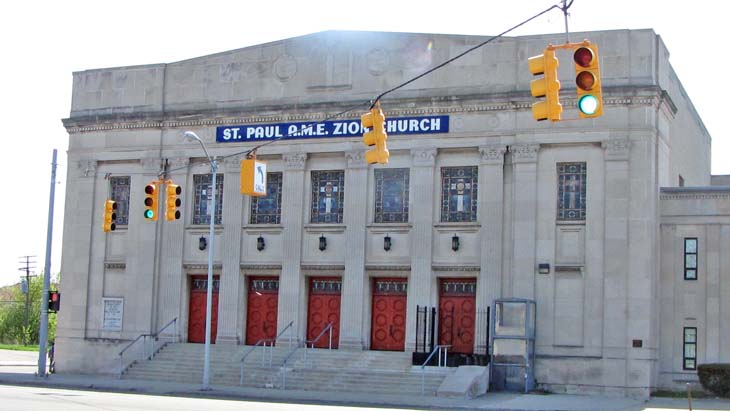

The 1920s were great years for building churches and synagogues in Detroit. The population grew rapidly, there was nearly full employment and wages were relatively high. Very many Detroit residents in 1930—59 percent of the 1.6 million city residents—were immigrants or children of immigrants, so they had close ties to the European religious traditions of their forebears. The massive structure you see pictured above with the symbol of the Ten Commandments engraved above the entrance was the second of four temples for this congregation.
Nine Hungarian Jewish men created a congregation in September, 1911 and named it shul Bait Eliyahu in honor of one of their members. The congregation grew, and by 1917, built a synagogue at Beaubien and Garfield where the Dingall Veterans Administration hospital now stands just to the east of Woodward. Money was needed to construct that building. You might think that selling the name of a stadium or a college building for cash is a new development. Apparently, it is not. The leaders of this congregation offered to the highest bidder the right to select a name. Moshe Gunsberg won the bidding hence the name, B'Nai Moshe or Sons of Moshe.
This very substantial Neo-Classical building was designed by the architectural firm of Hector Payne and Kohner. In addition to churches and synagogues, the 1920s were years in which dozens of legitimate theaters and movie houses were constructed in Detroit. Payne and Kohner had developed something of a reputation for theater design in the city. I believe they designed the Ramona Theater on Gratiot, the Uptown Theater on Mack and the Norwest on Grand River. All of these have been demolished so this synagogue may be their only surviving structure. Congregation B'Nai Moshe moved into this structure in 1929. Five years later this Orthodox congregation merged with the Detroit Hungarian Hebrew Congregation.
The early post-World War II years must have seemed prosperous ones for this congregation and a good time for expansion. By 1951, a large school building was constructed on the campus. But demographic trends were moving rapidly and I presume that Jewish leaders, similar to those in the Catholic diocese, did not appreciate how federal housing policies would redistribute the faithful to the suburbs and make inner city churches and synagogues useless.
In 1959, this Congregation moved to the suburbs with a new synagogue at Ten Mile and Kenosha in Oak Park. Thus, in the course of two generations, the residents in this congregation moved from living just to the east of Woodward in downtown Detroit, to the West Side of Detroit and then into the inner ring suburb of Oak Park. About thirty years later, demographic change had its impact once again. The congregation sold its synagogue in Oak Park in 1989, and in 1992, opened a new one at 6800 Drake Road in West Bloomfield Township.
Hungarians were, perhaps, one of the more religiously diverse groups to migrate to Detroit in large numbers. This Hungarian congregation has been in the suburbs for more than one-half a century. The Szent Janos Templom in southwest Detroit that served the Hungarian Orthodox community closed in the 1980s or earlier. However, Holy Cross Church, also in southwest Detroit, continues to serve its Roman Catholic parishioners and may now be the only Hungarian language religious organization in the Detroit area.
I do not know much about the St. Paul African Methodist Episcopal Zion congregation that now utilizes this synagogue. They should not be confused with the St. Paul African Methodist Episcopal congregation whose church is located at 2260 Hunt Street in Detroit. Henrik Kohner was something of the architect for Hungarian religious communities in Detroit regardless of their denomination. He designed Szent Janos Templom in 1911 for Orthodox Hungarians and Holy Cross for Hungarian Roman Catholics in 1924. Then he moved on to work with Hector Payne in the design of the synagague you see here, one that opened in 1929. The economic crisis of the Depression and the war demands of the early 1940s meant that most architects had few or no commission from 1929 until the late 1940s. Henrik Kohner lived long enough to resume his career and he designed one of the about two dozen new synagagues erected in Detroit after World War II: Yeshivah Beth Yuheda Mogen Abraham, also on Dexter.
Architects: Hector Payne and Henrik Kohner
Architectural Style: Neoclassical with many symbols of Jewish beliefs engraved on the Dexter Avenue front
Date of completion: 1929
Website for Congregation B’Nai Moshe: http://www.bnaimoshe.org/
City of Detroit Designated Historic District: Listed October 19, 1998
State of Michigan Registry of Historic Sites: Not listed
National Register of Historic Places: Not listed
Use in 2011: AME Church
Photograph: Ren Farley; May 9, 2011
Description updated: June, 2012
Return to City of Detroit Historic Designations